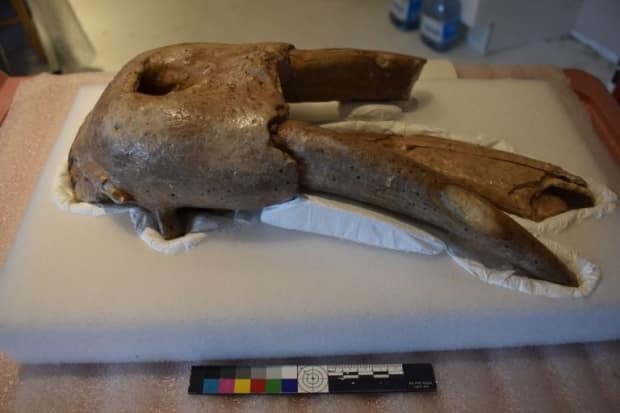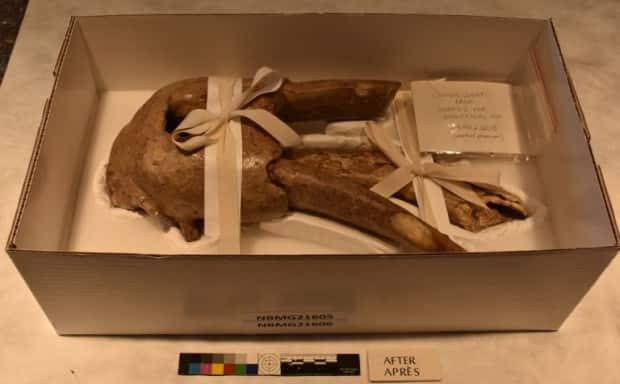Walrus skulls thousands of years old are cleaned up and preserved at N.B. Museum
Submerged in saltwater their discovery in the Bay of Fundy, two prehistoric walrus skulls are now resting peacefully at the New Brunswick Museum in Saint John.
Scallop fishermen from St. Mary's First Nation discovered one of the skulls in the Bay of Fundy in 2016 and the other skull in the same area in 2019.
The First Nation donated the skulls to the museum, which estimated they were up to 10,000 years old. Walrus haven't been seen in the Bay of Fundy since the 1700s.
Dee Stubbs-Lee, the museum's conservator, said both skulls were, and still are, fragile and had to be kept submerged in saltwater at the start to prevent further degradation.
"if you think of seawater, you know how salty it is," said Stubbs-Lee.
"Unfortunately, those salts would crystallize and become much bigger, much faster than the surrounding bone and ivory and would essentially cause it to explode."
The walrus skulls were brought into the museum in Coleman coolers filled with seawater.
Skulls salty
Then came the long process of preserving the skulls.
This was complicated by the fact the skulls are essentially made of three materials: teeth, ivory and fossilized bone.
"And all of these materials react differently to the environment," said Stubbs-Lee.
"So it's very difficult to find something that's going to make all of those materials happy at the same time."

The first step was to start removing the salt from the walrus skulls by slowly diluting the saltwater with fresh water.
"I changed out the saltwater for freshwater … very slowly, about 200 millilitres a day over the course of about a month," said Stubbs-Lee.
"I monitored the salinity in the water. … When I started out, it was about 30 per cent. And after a little over a month, it got down to zero per cent. So I knew that basically, all of those nasty salts that were in there had been flushed out, and then we could start the process of drying it. "
Drying out
The drying process took about a year and a half to complete, with the skulls being placed in what Stubbs-Lee describes as a large ziplock bag and occasionally weighing the bag until she was sure the skull had dried out.
But there was a bump along the way.
"There was a period where we had a bit of a glitch with our heating system, and the lab got very hot and very dry for a few days. And that really accelerated things faster than was ideal," said Stubbs-Lee.
The ivory tusks had started to flake, which concerned Stubbs-Lee, especially considering the skulls' possible use in research.
"We have a very long view in the museum," she said.

"We're thinking very much in terms of what are the consequences of everything we decide to do or not to do today. What are the consequences of that decision, you know, 10 years, 50 years, 100 years, 200 years down the road."
To obtain as much information as possible, Stubbs-Lee enlisted colleagues in the museum's geology department to essentially create a 3D scan of the skulls.
"It's essentially hundreds of different individual images of the specimen that are stitched together in a computer program so that you can manipulate it in space, you can turn it around, you can look at the underside, you can lift it up, you can change the angles, all that sort of thing, without actually touching the original specimen," said Stubbs-Lee.
"That way we knew that that information that's inherent in the specimen or at least part of the information, would be safe regardless of what happened with the original."
The skulls are now stored at the museum's Douglas Avenue building in a custom-made case, locked in a metal cabinet in the geology collection.

